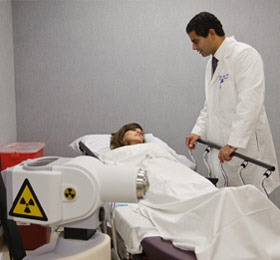Brachytherapy Treatments
Brachytherapy is the placement of radioactive sources in or just next to a tumor. The word brachytherapy comes from the Greek “brachy” meaning short distance. During brachytherapy, the radioactive sources may be left in place permanently or only temporarily, depending upon your cancer. To position the sources accurately, special catheters or applicators are used.
There are two main types of brachytherapy — intracavitary treatment and interstitial treatment. With intracavitary treatment, the radioactive sources are put into a space near where the tumor is located, such as the cervix, the vagina or the windpipe. With interstitial treatment, the radioactive sources are put directly into the tissues, such as the prostate.
Sometimes these procedures require anesthesia and a brief stay in the hospital. Patients with permanent implants may have a few restrictions at first and then can quickly return to their normal activities. Temporary implants are left inside of your body for several hours or days. While the sources are in place, you will stay in a private room. Doctors, nurses and other medical staff will continue to take care of you, but they will take special precautions to limit their exposure to radiation.
Devices called high-dose-rate remote afterloading machines allow radiation oncologists to complete brachytherapy quickly, in about 10 to 20 minutes. Powerful radioactive sources travel through small tubes called catheters to the tumor for the amount of time prescribed by your radiation oncologist. You may be able to go home shortly after the procedure. Depending on the area treated, you may receive several treatments over a number of days or weeks.
Most patients feel little discomfort during brachytherapy. If the radioactive source is held in place with an applicator, you may feel discomfort from the applicator. There are medications that can relieve this discomfort. If you feel weak or queasy from the anesthesia, your radiation oncologist can give you medication to make you feel better.
Depending on the type of brachytherapy you received, you may need to take some precautions after you leave your treatment, particularly if you plan to be around young children or pregnant women. Ask your radiation oncologist or radiation oncology nurse about anything special you should know.
